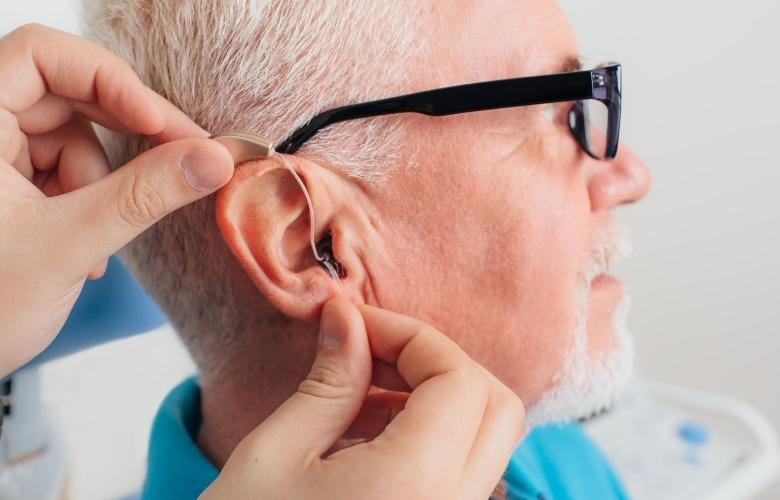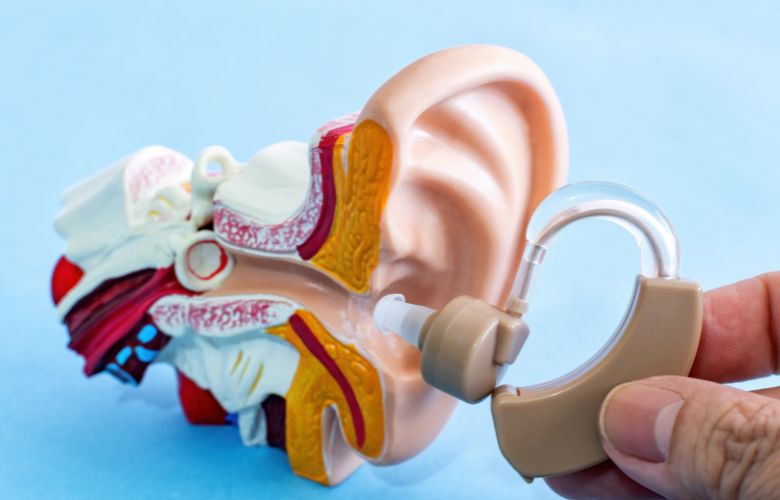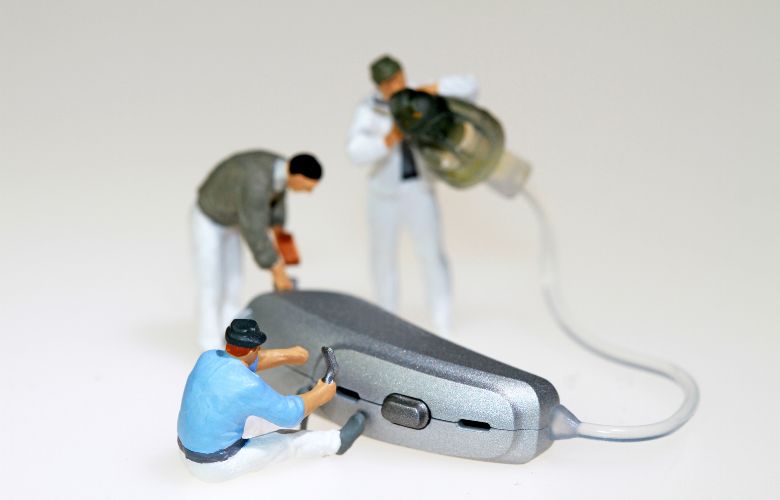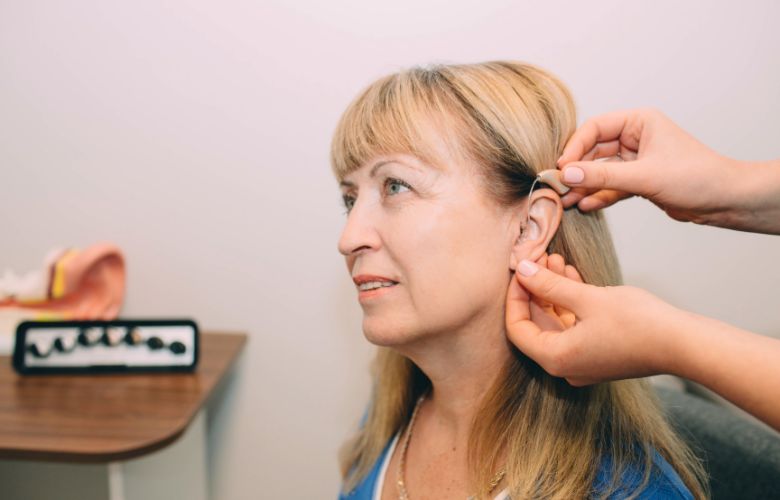Millions of people experience hearing loss on a regular basis, and hearing aids have emerged as a crucial management tool. Modern hearing aids have experienced major adjustments and enhancements recently as a result of technological advancements, including the addition of hearing aid channels. In essence, hearing aid channels are various frequency bands that let users adjust the sound quality to suit their particular hearing demands. The advantages of hearing aid channels, their functionality, and how to select the best channels for your needs will all be covered in this blog.
What Are Hearing Aid Channels?

A channel is a filter that covers a wide frequency range and is processed, analyzed, and reproduced by a hearing aid in the same way. A broadband hearing aid, or a single-channel hearing aid, has a bandwidth of 100 Hz to 8000 Hz. It treats all sounds in that frequency range as one sound. It is used to compute (or analyze) the average sound level across all frequencies (100-8000Hz). Furthermore, it is processed using the same gain across all frequencies and produces (or outputs) the same sound with its original details, except that it is louder.
Multichannel hearing aids do not necessarily mean hearing aids with greater bandwidth, i.e., more frequencies. It simply means that the hearing aid splits the incoming sound into different frequency areas for processing, analysis, and reproduction. A 3-channel hearing aid might treat sounds below 1000Hz as the low-frequency channel. Sounds between 1000 and 3000Hz are the mid-frequency channels. All sounds above 3000Hz are high-frequency channels. It will calculate (or analyze) the average sound level in each region of low, middle, and high frequency.
And a 16-channel hearing aid will adjust the sound from low frequency to high frequency, divided into 16 different points. The more channels, the more precise the sound compensation will be, which will be closer to the original sound.
About Hearing Aid Adjustable Channels

The hearing aid debugging interface displays adjustable channels (also called frequency bands), and the real compression and amplification of the sound are achieved through the processing channel. Similar to a mobile phone, you can increase or decrease the sound output through the volume buttons, but when actually playing music, the operator can’t adjust the low, middle and high tones.
Therefore, in actual operation, the hearing aid can only be changed by adjusting the gain on the adjustable frequency band. The refined parameters on the processing channel depend on the performance of the hearing aid itself. The better the performance, the more refined the processing channels.
However, a flat listening curve does not require many channels to adjust gain and compression, and even an uneven listening curve only needs 3 to 8 channels to adjust.
For patients with flat or non-rapid hearing impairment, hearing aids with more channels may not necessarily hear better than those with fewer channels.
Studies have shown that the speech recognition rate of 8-channel hearing aids is not significantly different from that of 12-channel and 16-channel hearing aids. This also reminds us that different brands cannot directly use the number of channels to compare the good and bad of hearing aids.
So don’t limit yourself to the number of channels. Because besides the hearing aid channels, the hearing aid’s output power, chips and algorithms, are the key factors when choosing your best hearing aids.
Types of Hearing Aid Channels: Analog vs Digital

A crucial component of contemporary hearing aids that enables more specialized and precise sound processing is hearing aid channels. Analog and digital channels are the two primary categories of hearing aid channels. You can select the ideal hearing aid for your specific hearing needs by being aware of the variations between these two sorts of channels.
- Analog Hearing Aid Channels:
Older technology is used by analog hearing aids to amplify sound. They function by taking in sound waves, turning them into electrical signals, and then amplifying and sending those signals to the ear through a speaker. Analog hearing aids typically have one to four channels, which is one to four less than digital hearing aids. A particular frequency range is intended to be amplified by each channel in an analog hearing aid. For instance, the analog hearing aid can be configured to boost only the higher frequencies if you have hearing loss in those ranges.
Analog hearing aids, on the other hand, lack the advanced processing capability of digital hearing aids, which might result in less accurate amplification and less clarity in sound. Additionally, analog hearing aids are sometimes less expensive than digital ones, making them a more practical choice for some users.
- Digital Hearing Aid Channels:
Digital hearing aids process sound using more sophisticated technologies. They function by turning sound waves into digital signals, which a computer processor subsequently processes. As well as offering capabilities for noise reduction and voice enhancement, digital signal processing enables more precise and personalized amplification. Analog hearing aids normally have fewer channels, but some digital ones have up to 64 channels. A digital hearing aid’s channels are each built to magnify a particular frequency range, enabling more specialized and personal sound processing.
Digital hearing aids can also automatically adjust to various listening situations, such as noisy dining establishments or peaceful bedrooms. They are therefore a well-liked option for those with more complicated hearing requirements. However, due to their sophisticated technology and processing power, digital hearing aids typically cost more than analog hearing aids.
Benefits of Using Hearing Aid Channels

- Customized Sound Amplification: Depending on your specific hearing requirements, hearing aid channels can offer specialized amplification for certain sorts of sounds. For instance, if you have a hearing loss that affects high frequencies, your hearing aid can be designed to boost only those frequencies, improving your ability to hear high-pitched noises. As opposed to digital hearing aids, which have channels that are more precisely tuned to provide even more exact amplification, analog hearing aids have channels that are designed to magnify a specific frequency range.
- Improved Speech Understanding: For those who have hearing loss, interpreting speech can be particularly difficult, especially in noisy surroundings. Speech frequencies in particular can be amplified by hearing aid channels, which makes it simpler to discern speech from background noise. For instance, a hearing aid may be designed to boost human speech frequencies (between 2000 and 8000 Hz) while attenuating other frequencies. This can enhance speech comprehension in a number of settings, such as crowded restaurants and quiet talks.
- Reduced Feedback and Background Noise: Background noise and feedback may be quite difficult for those with hearing loss. Feedback is that unpleasant whistling sound that occasionally happens when you wear a hearing aid. By offering more precise amplification and noise reduction algorithms, hearing aid channels can aid in the reduction of both of these problems. Each frequency range can be handled separately when there are numerous channels, which lowers the possibility of feedback. Additionally, digital hearing aids’ noise reduction algorithms can help to lessen background noise, which improves speech understanding.
- More Comfortable Listening Experience: Hearing aid channels can offer a more cozy and pleasurable listening experience with tailored amplification and less feedback and background noise. This can be crucial for those who use hearing aids for extended periods of time as it can lessen listening fatigue and improve overall hearing aid satisfaction.
- Better Adaptation to Different Listening Environments: Hearing aids with multiple channels can alter the amplification of various frequencies in accordance with the various listening settings. For instance, at a noisy restaurant, the hearing aid can improve speech understanding while minimizing background noise by amplifying some frequencies while amplifying others. People with more complicated hearing needs who might find it difficult to hear in different listening contexts may find this adaptability to be especially useful.
- Improved Sound Quality: Hearing aids with multiple channels can deliver better sound quality by processing various frequency ranges more precisely. A clearer, more realistic sound that is simpler to separate from background noise can arise from this. It is also possible to fine-tune the hearing aid more effectively, which can result in more accurate amplification and a more natural listening experience because it can process various frequency ranges independently.
- Increased Control: You can fine-tune your hearing aid to your unique needs by controlling the amplification of particular frequencies better with more channels. People with more sophisticated hearing needs, such as those who have severe or profound hearing loss, may find this to be especially beneficial. You can more effectively target the areas where you have the greatest trouble hearing by altering the amplification of particular frequencies, which improves speech comprehension and overall listening comfort.
How to Choose the Right Hearing Aid Channels for Your Needs

The hearing experience you have can be significantly impacted by your choice of hearing aid channels. The following are some things to take into account when choosing the best hearing aid channels for your requirements:
- Type of Hearing Loss: The number of channels your hearing aid needs will depend on the kind and degree of your hearing loss. For correct amplification of various frequency ranges, people with minor hearing loss may only need a few channels, whereas those with severe or profound hearing loss may need more.
- Lifestyle: Take into account your routines and the settings you are most often in. Do you frequently go to loud events or work somewhere noisy? If so, a hearing aid with more channels and sophisticated signal processing algorithms to help reduce background noise may be beneficial for you.
- Budget: More modern hearing aids with more channels are frequently more expensive. Examine your spending plan and decide if you’re willing to shell out extra money for a hearing aid with more channels and sophisticated capabilities.
- Personal Preferences: Since each person has unique hearing requirements, it’s vital to test out many hearing aids with various channel combinations to find the one that works best for you. Fewer channels may offer a more natural listening experience for certain people, while more channels may be preferred by others.
- Compatibility with Other Devices: Consider a hearing aid that is compatible with your other electronics if you use them, such as your television, tablet, or smartphone. This enables you to control your hearing aids with your phone or other device while streaming audio directly to them.
Tips for Adjusting Hearing Aid Channels

Adjusting hearing aid channels can be an important part of getting the best possible hearing experience. Here are some tips for adjusting hearing aid channels:
- Start with a Hearing Test: It’s crucial to start with a hearing test to identify your unique hearing needs before altering the channels on your hearing aid. Your hearing healthcare professional and you can use this information to make educated decisions about how many channels to use and how to alter them.
- Make Small Adjustments: It’s vital to make incremental adjustments rather than significant ones when changing the hearing aid channels. By doing so, you’ll be able to tune the hearing aid more precisely and prevent it from becoming uncomfortable or overly loud.
- Give It Time: Your brain might need some time to adapt to the new settings after you first change the hearing aid’s channel settings. Prior to making additional adjustments, give yourself some time to become adjusted to the new settings.
- Use Real-world Situations: Try utilizing your hearing aids in actual conditions when altering the channels, like during conversations or in noisy settings. This will enable you to assess whether the adjustments you’ve made have improved your hearing quality.
- Consult Your Hearing Healthcare Professional: Do not hesitate to speak with your hearing healthcare provider if you are having trouble adjusting the channels on your hearing aids or if you are not experiencing the desired results. You can benefit from their additional advice and assistance to make the most of your hearing aid.
Conclusion
People with hearing loss can hear better thanks in large part to the channels in their hearing aids. Different frequency ranges can be processed by many channels, creating a crisper, more lifelike sound that is simpler to differentiate from background noise. Additionally, extra channels give you more control over how loud certain frequencies are amplified, which enhances speech comprehension and listening comfort. The type and degree of your hearing loss, your lifestyle, your financial situation, your personal tastes, and your compatibility with other devices should all be taken into account when choosing the best hearing aid channels for your needs. You can enhance your hearing and live a better quality of life by working with a hearing healthcare specialist and heeding advice for changing hearing aid channels.


